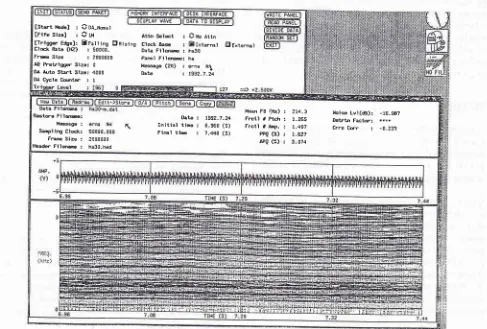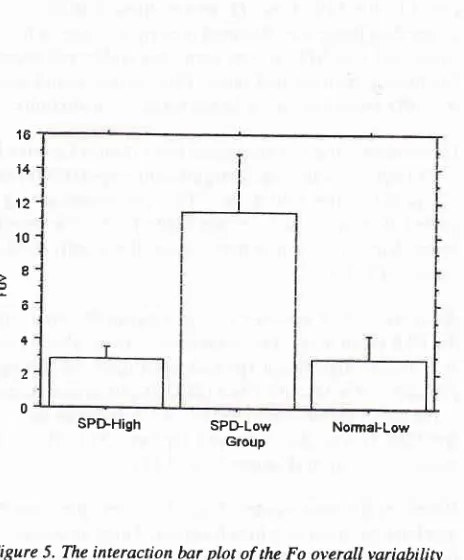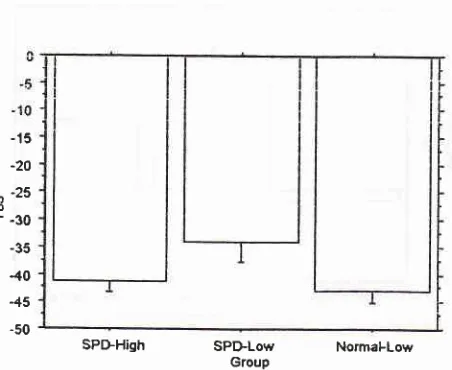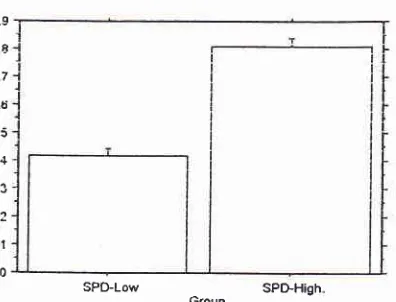158 Abdoenochman et al. Med J lnàones
Objective Documented Study on Stipulated Target-Tone.
Test of
Vocal Controllability with
the
Electromyography background
mechanism.
Hartono Abdoerrachmanl, Satoshi Imaizumi2, Seiji Niimi2, Masanobu Kumada2
Abstrak
Penderito disfonia mempunyai kesulitanuntukberkonunikasi sehari-hari, knrenaadanyakesulitan ntengucapknn lata-katasecara tepat pada nada suara normal. Atas dasar itu, makn telnh dilakukan analisa akustik dan elektromiografi pada penderita kclainan suara neurologik dan penbicara nonnal sebagai pembanding. Keadaan tersebut ternyata disebabkan karena adanya peningl<atan nilai Parameter analisa suara serta adanya penurunan alclivitas potensial otot-otot Vocalis dan Crycothyroideus. Sebaliknya pengucapan suara dengan nada yang tinggi (high pitcly'falseno) rcrnyata secara bennakna dapat meningkatkan kemampuan penderita untuk mengontrol pengucapan kata-kata. Hasil tersebut nenunjukan bahwa peningkatan kennntpuan pengucapan lata-kata terjadi karena adanya perbailan kualitas kantraksi otot-otot suara.
Abstract
A study of acoustic analysis and electronryography upon neuro-pathological condition ofvoice disturbance and nonnal speakers had been conducted. This study was based on the complaint that dysphonic patients are having dfficulties on controlling their voice volitionally and the accuracy for daily verbal comnunication. The results indicated that voice disturbance was related to the increased parar,reter values extracted onvoice analysis andthe decreased of the potential action of the Vocalis and Crycothyroid tnuscles. However, significant changes of vocal controllability was obtained during the high pitcly'falsetto voice of the stipulated target tone. The phenontenon indicate that when subiects produced stipulated target-tone, the vocal controllability were inproved due to the betterttrcnt
of the muscles action.
Keywords : Voice analysis, acoustic anal76is, vocal controllabili\,, sl..rrtrryography.
INTRODUCTION
Patients with either neurological or laryngeal disorders tend to complains of having difficulties in controlling their voices, flexibly and volitionally for daily verbal communication.
"'
It
iswell
accepted that the voiceproduction,
especially the speech productionis
in-fluenced complexlyby
the
constellation worksof
laryngealintrinsic
muscles.It
is
known that
the Vocalis and the Cryco-thyroid muscles are the twolaryngeal
intrinsic
muscleswhich
are primarily
responsible for the increasing vocal pitch.Imaizumi et
aL,
3'4 AMoerrachm an etal.,l's
Hiror"
et a1.,6 have reported their investigations concerningthe
analysisof
vocal
controllability
in
differentI
Departtttent of Otorhinolaryngology, Faculry of Medicine, "U ni v'e rs i ty of I nd o nes i a, J akar t a, I ntl o nes i a
'Research Institute of Logopedics and Phoniatrics, Fac. of Medicine, Univ. of Tokyo.
pathologies of the larynx. However, they mostly used a single mode of pitch and amplitude in producing the voice samples. Since that the daily conversation is
full
of intonations, thus, it is important to assess the voice conditions with different mode of phonations, the low and high pitchs. Voice controllability is defined as the ability of subjects to keep the fundamental frequency and amplitudeof
voice as constant as possible when instructed to produce sustained vowel.The aim of this investigation was to explore the back-ground mechanism of voice alteration base on a given task to the subjects to increase their voices to reach the stipulated target-tone (falsetto voice) through an
objec-tive
electro-myographic(EMG)
recordingof
the potential muscle action and assessmentof
their the vocal controllability.Vol 5, No 3, July - September 1996
producing the stipulated high tone (high pitch, falseto), the perturbation value was decreased in accordance to
a better vocal controllability. EMG analysis revealed that the improvement of vocal controllability was due
to
eitherby
increased numberof
motorfiring
units and/or a higher firing rate in a single unit of the Vocalisand Crycothyroid muscles.
METHOD
Subjects
for
the study were2
SPD patients and 2 normal / healthy voice volunteers which have not any history of pathology affecting phonation as the control group. The modal voice samples producedat
most comfortable level and pitch by healthy speakers.Voice samples collection were pe.rformed by recording sustained vowel /a/ produced by subjects as long as they were able
to.
SPD patients were requested to produce sustained vowel /a/ at comfortable level andpitch (SPD-Lo*),
and followedby
stipulated high pitch (SPD-High, falsetto), in fractional steps. Record-ings were made using in a sound attenuated room with theDAT
tape-recorder,with
constant distance from microphoneto
mouthof 15
cm, following repeated patient's practice.Voice samples
of sustained
lal
were then digitized through a 16-bit analog to digital (A/D) converter at a sampling rate of 40 kHz and stored on a disk controlled by computer. A half second segment was extracted by excluding theinitial
andfinal
portionsfrom
eachsample.
The
token segment were chosenfrom
theregular-like portion of phonation by looking at the Fo time series and the sonogram, confirmed by perceptual judgment, Saturated recording of sustained vowel, and
also erratic and disrupted portions were excluded.
Detection of local maximum points of the voice were done by using the wave-form matching and peak pick-ing method, which was proposed by Imaizumi et al.t .
Local maximum points of the voice waveform is cor-responding
to
the vocal excitation epochsof each
glottal cycle. This were followed by determinationof
the two time series of Fe(i) and A(i), as the fundamental frequency and the maximum amplitude of i-th glottal period.Moreover, cycle by cycle perturbation quotients were calculated and several voice properties were also been
extracted.
Pitch
Perturbation Quotient (PPQ) andAmplitude Perturbation Quotient
(APQ)
represents the arnount of fast fluctuations in pitch (inverse Fo) andVoice Analysis
onTbrgetlone
159amplitude. However, these parameters do not explicit-ly illustrate how fast the fluctuations are.6
The additive noise level (Noise Level) is the difference in deci-Bell (dB) between the energy
of
the non-har-monic and that of the harmonic components, within I -4kHz
frequency range. The harmonics and non-har-monics components were extracted from voice wave-form using a comb filtering method.e This parameters represents the magnitude of noise comlnnents, which may be responsibleto
"breathy" and "hoarse" voice quality.The overall variability of Fo (FoV) is the percentage
of
the standard deviation normalized by the averageof
F"(i). A logarithmic transformation is used for statisti-cal analysis. This parameter represents an instability
of
F". The larger values indicates the more instability in controlling Fs.Fast fourier transformation of the power spectra were used to calculate the slow (FoS) and fast (FoF) fluctua-tion of the energies in Fo(i). Followed by the calcula-tion
of
the energies in the frequency ranges between0<f<16 and 16<=fcaverage F"12. F symbolized the frequency in Hertz (Hz). Finally the logarithmic trans-formed values are normalized by DC level. FsS repre-sents the magnitude of Fo fluctuation which is slower than 16 Hz, while FoF is that of faster than
16Hz
The Vocalis and Cryco-thyroid muscles activities for comfortable voice (SPD-Low) and high pitch (falserro,
SPD-High) were recorded through bipolar hooked wire electrodes, The second halfs EMG record were
token as the sample. This regular-like phase was ex-tracted by looking at the Fo time series, excluding the
initial and the final portions, To obtained quantitative data of the token samples, the EMG data were then
executed and rectified, integrated, smoothed using EMGPRO-program, and
finally
normalizedby 0.5
second segmentof
sinusoidal wave-form calibration (300uV/klÉz).roCalculation of the analysis oivariance (ANOVA) were done using
the
STATVIEW computers program.RESULTS
An experimental study to analyze the vocal perturba-tions and
the
potential actionof
the Vocalis anda
[image:3.595.71.558.93.422.2]160 Abdoetachman et al. Med J Indones
Figure l- Feature of analyTsfl voice sample using 'SONG "-prograil, with 4 panels: A) display of cotntnands, B) display of eilracted voice properties wilh the scores, C) acoustic wave-fornt, and D) voice spectrogra,n or the sonograty.
Voice perturbations which were revealed
in
several extracted parameters can be seen in Figure 3 (PPQ), Figure 4 (APQ), while Figures 5, 6 and 7 represented FoV , FoS and FoF. Significant differences (p<0.0001)was noted on decrements between SPD-Low and SPD-High.
The simultaneous acoustic wave-form EMG pattern
of
the Vocalis and Cryco-thyroid muscles were shown in Figure
9.
Figure 10 and1l
demonstrated thesig-nificant differences (p<0.0001) of the potential action during the SPD-Low and SPD-High.
DISCUSSION
SPD voice
is
acquainted as strain-strangle, striving, jerky, tremorous with intermittent voice stops.How-ever, the "normal-like" pattern was still noted between
the disruptive voice profile. This experiment was done
with
a
special intention to these pattern.The SPD-High (falsetto) speakers showed an increased mean value which exceeding the normal fundamental frequency (Figure
2).
The
increaseof
pitch was ef-fected by the contraction and increased activationof
The Cryco-thyroid and Vocalis muscles, which act asthe adductor and tensor of the vocal folds.
The pitch perturbation quotient (Ppe), the amplitude perturbation quotient
(APO
and the fast and slow Fo perturbation (FoF andF6S)
which were decreased significantly on SPD-High (falsetto) as compared tothe SPD-Low speakers, indicated that by increasing the
pitch into falsetto-tone there were a decreased in the magnitude scores of perturbations.
The
overall variability
of
fundamental frequency (FoV), which was represented the Fo instability found to be decreased significantly (p<0.0001) on SpD-High(falsetto voice). This data showing that the high pitch
voices were less fluctuating, and more stable as com-[stTtHod€] : ODA_Nmal
[Ftfo si.e] : O:n Àttn S€læt : CNo Attn
clæk 8â* : (Blnternal {Ilsxternal Datâ Fllaæ: ha30
Paæl Fl'læ: ha Lesâgo (20) : ernâ N\ Date . 1992.7-24
[Trl99æ Edge]: Bratting Elnrstng Clæx Râts (le) : 50000. Fæ Slze : 2000000
Att Pretrlggr Size: 0
0Â ùto Stârt Slze: 4000
Oâ Cycle Cqrtr : I
Rætfo Fllffi: Hegs : Sanplirlg Clock:
Fm€ Size : H€.df Filffie :
t!.t€ : 1992.2.24
Initial tine : 6.960 (S) Fiml tlæ : ?,440 (S)
Heù F0 (Hz) : 214.3 l,oise Lvl(d8): _16.907
Frctl J Ptcà : 1.265 lEtr-tl F.ctr: r.r. Frctl a Àrp. : 1.497 Crrs Cor , -O,2AX
PPq (:) : 1.627
Vol 5, No 3, July - September 1996
[image:4.595.306.531.135.315.2]SPlHigh
Figure 2. The interaction bar plot of nteanfundanrental frequency Qnean Fo - in Hz) of the groups.
3
2.5
0-^ 4! o = .ë' r.s
1
.5
0
[image:4.595.50.277.137.312.2]SPDHish SFD-Low NormaFLow Group
Figure 4. The interaction bar plot of Loglo Atttplitude Perturbation Quotient (APQ - %) of the groups.
Voice Analysis on TArget Tone 161
[image:4.595.310.542.436.716.2]SPEFHigh
Figure 3. The interaction bar plot ofLoglo Pitch Perturbation Quotient (PPQ - %) of the groups.
16
i4
12
t0
o
o
4
2
0
SPlHigh SPDLow NormaFLow Group
Figure 5. The interaction bar plot ofthe Fo overall variability (FoV) of the group.
500
450 400
^ 350
j 300
E 250 û
-
?00150
100
50
[image:4.595.49.284.439.719.2]r62 Abdoenaclman et aL
-15 -20
,
-25o
*
-30-54
-{0
-45
-50
SPlHish SPDLow Normal-Low
[image:5.595.71.297.142.327.2]Group
Figure 6. The interaction bar plot ofthe Slow Fo Perturbations ofthe group.
pared to the SPD-Low. However, those values were
larger than the scores obtained in normal voices, which
suggested that SPD voices were less stable and more
fluctuating than normal ones. Thus,
it
was found thatthe SPD-High showing a better vocal controllability.
Furthermore, the additive noise level (Noise Level)
of
SPD-High were decreased significantly (pcO.OOOl) as
compared
to
theSPD-Low.
This phenomenonsug-gested that the falsetto voice (SPD-High) contained more harmonic components than
the
comfortable voice (SPD-Low).An increased
of
almost twice in magnitude scoreof
the EMG data of the Vocalis muscleaction, which was
statistically significant (p) had been detected during production the falsetto voice (SPD-High) as compared to the comfortable voice (SPD-Low). Similar tendency
Cr=0.0001) was also observed for
the
Cryco-thyroidmuscle activation (Figures 10 and 11).
Based on the neuro.physiological aspects, the were 3
mechanisms related to the elevation of muscle
contrac-tion activity. First,
it
is due to the increasing number of its muscle units which are activated. Secondly, by-25
â
'-30
-35
SPDHigh SPlLow Normal-Low
[image:5.595.330.558.144.327.2]Group
Figure 7. The interaction bar plot ofthe Fast Fo Perturbations of the group.
the higher frequency
of
the impulsesin
each motor unit, and thelast
by the synchronization of different motor units.lI
Whiie, Titiet2 with his modelexperi-ment stated that the increases in number of motor units
and the mean motor unit firing rate, have an effect in
decreasing the Foperturbation value. Based on those
statement and our EMG and quantitative datas, we speculated
that
there wereat
least2
mechanisms,namely a higher
firing
ratein
a single unit, and anincreased number
of
motor units activated were in-volvedin
the falsetto voice production. Moreover,it
was seemed
that
these mechanism werepurely
aperipheral neuro-motoric phenomenon.
It is summarized that when the SPD subjects increased
their voices into the stipulated target-tone, the intrinsic laryngeal muscles action were elevated due
to
thehigher
firing
ratein
a single muscle unit and anin-creased
numberof
motor
unit
activation, whichresulted in a better condition of vocal controllability
of
their voices.
It
was shown that the acoustic analysis"yjt"-
used in this study was an effective method inevaluating the vocal controllability in either pathologic
and normal voice conditions.
Med J Indones
0
-c
-!0
4A
l(
Vol 5, No 3, July - September 1996 Voice Analysis
onTargetTone
163Figure 9. Recording of EMG for Vocalis and Crycothyroid
ttruscles, altogether with voice recording of acoustic wave-fonn
and the Fo titne series. The second half of chosen seguent was also shown.
| =3UOuV
.J
25
.15
.1
.05
0 -a1
-5 E
:
-7.s-:
-to.9
2 -12.5
-15
-tt.c
-20
-22.5
SPlHigh SPDLow NormaFLow Group
Figure 8. The interaction bar plot of the additive noise level (Noise Level in dB) of the Broup..
q B
.b'
,J .4
1
0
SPD-Low SPDHigh
Group
Figure 10. The interaction bar plot of the EMG qualitative data
of Vocalis nuscle activation on SPD-High and SPD-Inw voices.
SPlLow SPDHigh.
Figure Il.The interactionbar plot of the EMG quafiirailve
i
6-1
Abdoerrachman et al.The
information
mentioned above would appear toitave
a wide rangeof
applicability,particularly
indifferent pitch ranges or phonation modes. However,
it
is not yet clear whether these results which were observed in sustained vowel phonation were inherentin
running speech voice samples. Current researchbeing undertaken in order to demonstrates the
acous-tical analysis
of
running speech voice with different phonation modes in SPD subjects.REFERENCES
1. Abdoenachman H,Imaizumi S, Hirose H, Niimi S. Slow and Fast Perturbations in Voice. - A Preliminary Report -. Ann Bull RILP 1993 ;27 : t25-34.
2. Ludlow CL, Bassich CJ, Connor Np, Coulter DC. phonatory Characteristics of Vocal Fold Tremor. J phonetics 1988 ; 14 : 509-15.
3. Imaizumi S. Acoustic measurôs of pathological Voice Quality. J Phonetics 1985 ;21 :457-62.
4. Imaizumi S. Acoustic measurements of pathological Voice Qualities for Medical Purposes. proc. ICASSp 1986
;
1 :677-80.
Med J Indones
5. Abdoenachman H, Imaizumi S, Niimi S. Test of Vocal Controllability with Increasing pitch and Intensity. Ann Bull RILP 1994;28 :45-50.
6. Hirose H, Imaizumi S. Voice euality
in
patients with Neurological Disorders. Vocal Fold physiology:
Voice Quality Control 1994 ;I
:235-48.7. Imaizumi S, Gaufin f. Acoustical perceptual Characteristics of Pathological Voices : rough, creak, fry and diplophonia. Ann Bull RILP l99l ;25 : tO9-19.
8. Koike Y. Vowel Amplitude Modulations in patients with Laryngeal diseases. J Acoust Soc Amer 1969 ;45 :839-44. 9. Lim J, Oppenlreimer AV, Baida LV. Evaluation of an
Adap-tive Comb Filtering method for Enhanching Speech I)cgraded by White Noise Addition. IEEE Trans ASSp 197g
;26 : 354-58.
10. Hirose H, Gay T. The Activity of the Intrinsic taryngeal muscles in Voicing Control
:
Electromyographic study. Phonetica 1972;25 : I4O-@.ll.
HiranoM. Clinical Examination of Voice Disorders. Human Communication. l98l ; 5 : ll-24.72. ^fitze IR. A Model for Neurologic Sources of A periodicity in Vocal Fold Vibration. J Speech Hear Res l99L ; 34 :



